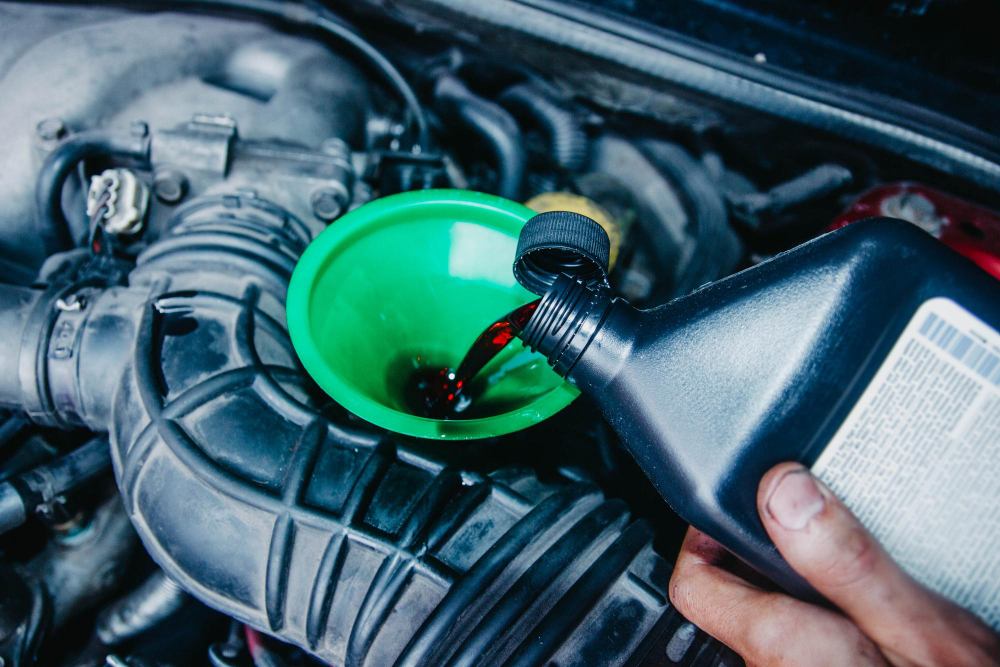White diesel vs. red diesel differ mainly in tax, legal use, and colour. White diesel (standard road fuel) is taxed at full rate and legal for all vehicles, while red diesel (rebated gas oil) is dyed red, cheaper, but restricted to off-road use like farming or construction. Using red diesel on public roads is illegal and can lead to fines or vehicle seizure.
In the UK, diesel is one of the most widely used fuels, powering everything from cars and trucks to agricultural machinery and backup generators. Yet, many people are unaware that there are actually two main types of diesel, white diesel and red diesel. While they may appear identical in appearance and performance, there are significant differences in terms of taxation, legal use, and pricing.
If you’ve ever wondered about white diesel vs. red diesel, their differences, or which one is right for your needs, this comprehensive guide will explain everything you need to know.
What Is White Diesel?
White diesel, also known as road diesel or DERV (Diesel Engine Road Vehicle), is the standard fuel sold at petrol stations across the UK. It’s the diesel that powers everyday vehicles like cars, vans, lorries, and buses.
It’s called white diesel simply because it is not dyed, the fuel has a pale yellow or clear colour in its natural form. This is the legal diesel for all road-going vehicles.
Key Characteristics of White Diesel:
- Used in: Cars, vans, HGVs, and all vehicles that drive on public roads.
- Taxation: Subject to full fuel duty and VAT, making it more expensive than red diesel.
- Storage: Can be stored for up to a year if kept clean and dry.
- Performance: High efficiency and engine protection due to advanced refining standards.
White diesel is produced to BS EN 590 standards, ensuring that it meets strict quality and emission requirements suitable for modern diesel engines.
What Is Red Diesel?
Red diesel, on the other hand, is the same basic fuel as white diesel, but with a red dye and chemical marker added. The dye allows authorities to identify it and easily distinguish it from standard diesel.
The main difference between red vs. white diesel lies in its intended use and taxation. Red diesel, officially known as rebated gas oil, is heavily taxed at a reduced rate, making it significantly cheaper. However, its use is restricted by law to specific off-road purposes.
Common Uses of Red Diesel:
- Agricultural machinery (tractors, harvesters, etc.)
- Construction and plant equipment
- Backup generators and heating systems
- Boats and some industrial machinery
Because of its lower tax rate, using red diesel in regular road vehicles is illegal and can result in severe fines or prosecution.
Red Diesel vs. White Diesel: What’s the Difference?
While both fuels are chemically very similar, their differences go beyond colour and price. Let’s break down the red diesel vs. white diesel comparison across several key areas.
Colour and Identification
The most visible difference is that red diesel is dyed bright red, while white diesel is clear or light yellow. The dye helps HMRC and other authorities detect illegal usage of red diesel in road vehicles during roadside checks or fuel tank inspections.
Even trace amounts of red dye can remain in a tank for months, so switching from red diesel to white diesel requires a full system flush to ensure compliance.
Taxation and Pricing
The red diesel vs. white diesel price difference is substantial due to taxation. Red diesel benefits from a significant fuel duty rebate, making it roughly 40-50 pence per litre cheaper than white diesel.
However, this reduced rate only applies to eligible users and purposes, as defined by HMRC. Using red diesel illegally on public roads is considered tax evasion and carries heavy penalties.
Legal Use
The legality of use is perhaps the most important distinction between white vs. red diesel.
- White Diesel: Can be used in all road vehicles and off-road applications without restriction.
- Red Diesel: Only permitted for specific uses such as agriculture, construction, forestry, marine, and heating.
Since April 2022, the UK government has tightened regulations on red diesel use as part of its drive to reduce carbon emissions and promote cleaner fuel alternatives. Many industries, including manufacturing, logistics, and commercial transport, lost their entitlement to use red diesel.
Performance and Composition
From a performance standpoint, there is little to no difference between the two fuels. Both are refined to the same standards and can power the same engines efficiently.
However, because red diesel is stored longer in tanks and used less frequently than white diesel, it’s more prone to fuel contamination, condensation, and microbial growth (diesel bug). Proper tank maintenance and the use of fuel stabilisers or biocides are therefore essential when storing red diesel for extended periods.
Environmental Impact
Both fuels produce similar emissions when burned, but many industries that use red diesel are transitioning to greener alternatives, such as HVO (Hydrotreated Vegetable Oil), to reduce their carbon footprint.
The government’s restrictions on red diesel use aim to encourage the adoption of such low-carbon fuels, especially in construction and industrial sectors.

Who Can Legally Use Red Diesel?
Only specific industries and applications are permitted to use red diesel legally. These include:
- Agriculture: Tractors, mowers, harvesters, and other farm vehicles.
- Construction: Cranes, bulldozers, and diggers operating off-road.
- Rail transport: Certain locomotives and maintenance vehicles.
- Marine: Commercial boats and fishing vessels.
- Heating: Generators, boilers, and static engines are used for heating and power generation.
If your business doesn’t fall under one of these categories, you must use white diesel or risk legal action.
Penalties for Misusing Red Diesel
Using red diesel in vehicles or machinery that aren’t legally permitted is a criminal offence. HMRC conducts random roadside and site checks to detect misuse, using fuel-testing equipment that detects the red dye.
If caught, you may face:
- Immediate confiscation of the vehicle or machinery.
- Heavy fines or penalties for unpaid fuel duty.
- Prosecution for deliberate misuse.
Even unintentional use, such as contaminated tanks or mixed fuels, can lead to penalties. It’s essential to maintain clear records and ensure that your vehicles use the correct fuel at all times.
How to Store and Handle Diesel Safely
Both red and white diesel require proper storage and handling to maintain fuel quality and safety.
Storage Tips:
- Store in bunded tanks compliant with environmental regulations.
- Keep tanks out of direct sunlight and away from heat to prevent oxidation.
- Regularly check for water contamination and microbial growth.
- Use fuel additives to extend shelf life and protect against degradation.
Red diesel can be stored for up to 2 years, while white diesel typically lasts about 12 months under ideal conditions.
Red vs. White Diesel: Cost Comparison
When it comes to red diesel vs. white diesel prices, red diesel is significantly cheaper due to lower tax duties.
For example, while prices vary depending on the supplier and market conditions:
- Red Diesel: Around £1.00 – £1.20 per litre
- White Diesel: Around £1.60 – £1.80 per litre
This price gap makes red diesel appealing for eligible users, especially in high-consumption sectors like farming or construction. However, the legal restrictions mean that not everyone can benefit from these savings.
Transitioning from Red Diesel to White Diesel
Since the 2022 tax reform, many industries have had to switch from red diesel to white diesel. This transition requires several important steps:
- Drain and clean fuel tanks to remove any red dye residue.
- Dispose of old red diesel legally, following environmental guidelines.
- Record the switch and update operational documentation.
- Train staff to avoid accidental refuelling with red diesel.
Failure to fully clean tanks can lead to contamination, as even trace amounts of red dye can be detected in tests.
Alternatives to Red Diesel
With red diesel restrictions tightening, many businesses are exploring alternative fuels such as:
- HVO (Hydrotreated Vegetable Oil): A renewable diesel alternative with lower carbon emissions.
- Biofuels: Derived from organic sources, but can have storage stability issues.
- Electric or hybrid power systems: Growing in popularity for smaller machinery and fleet operations.
These alternatives can help companies reduce their environmental impact while complying with legal requirements.
Red Diesel vs. White Diesel: Which One Should You Use?
The choice between red vs. white diesel depends entirely on your usage.
- If you operate road vehicles, you must use white diesel.
- If you work in agriculture, construction, or power generation, you may still be eligible to use red diesel.
Before purchasing, always verify your eligibility with HMRC and source fuel from a reputable supplier to ensure compliance and quality. Working with trusted suppliers like 123 Oil ensures you get clean, high-grade fuel suitable for your specific application.
Summary: White vs. Red Diesel
Feature | White Diesel | Red Diesel |
Colour | Clear or light yellow | Red (dyed) |
Legal Use | All vehicles on public roads | Off-road and specific applications only |
Tax Rate | Standard duty (high) | Rebated duty (low) |
Price per Litre | £1.60 – £1.80 | £1.00 – £1.20 |
Common Users | Drivers, hauliers, fleet operators | Farmers, builders, boat operators |
Storage Life | 12 months | Up to 24 months |
Penalty for Misuse | N/A | Heavy fines or vehicle seizure |
Final Thoughts
Understanding the difference between white diesel vs. red diesel is essential for staying compliant and managing costs efficiently. While both fuels are similar in performance, the legal restrictions and price differences make them suitable for very different purposes.
Always ensure you’re using the right fuel for your operation. Misusing red diesel can lead to serious financial and legal consequences, while proper compliance can keep your business running smoothly and sustainably.
For a reliable, compliant diesel supply, always choose a trusted UK supplier who understands your industry’s needs and can provide guidance on fuel management and storage.
Frequently Asked Questions
No. Using red diesel in road vehicles is illegal in the UK and can lead to fines or vehicle seizure.
No major difference. Both fuels perform similarly, but red diesel can degrade faster in long-term storage.
HMRC uses chemical tests that detect the red dye, even in trace amounts, making illegal use easy to identify.
Red diesel is around 40–50 pence per litre cheaper than white diesel due to lower tax rates.
Only specific industries, such as agriculture, marine, and rail transport, are still permitted. Others must switch to white diesel or alternative fuels.










